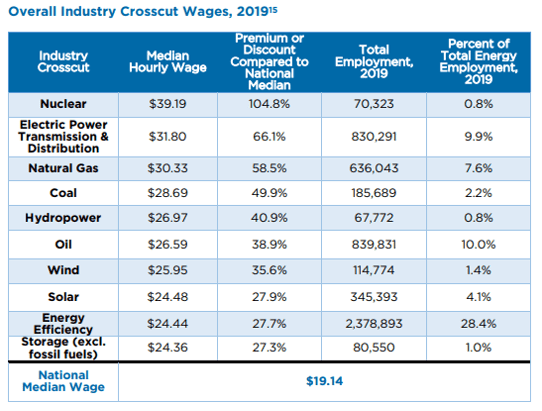A new report from the National Association of State Energy Officials and Energy Futures Initiative analyzes jobs and wages across the energy sector.
A quick look at the report shows median pay in the hydropower industry is $26 per hour, nearly 41% higher than the national median wage of $19 per hour and slightly higher than wages in the wind and solar industries.
The chart below, extracted from the report, give a snapshot of the wage information, based on 2019 data.

Beyond wage information, the report also provides details about the number of new jobs per sector. According to the report, from 2015 to 2019, the hydropower industry created 2,200 new jobs, a growth rate of more than 3%.
Compared to other energy industries, these new hydropower jobs likely paid higher in nearly every single category, as shown in the chart below extracted from the report:

The report also serves to showcases the number of jobs in hydropower, versus in other renewables.
One observation worth noting in this regard: in 2019, the report shows that hydropower provided less than 5% of all jobs in electricity generation, but 7% of total generation. On the other hand, solar provided 24% of all electricity jobs, but less than 2% of generation.
WHY IT MATTERS — HOW TO USE THE FINDINGS FROM THE REPORT
The report is validation that federal investment in hydropower creates good paying jobs, an important finding as the Biden Administration pursues the dual tracks of economic recovery and climate change mitigation.
It’s also an important finding as the industry grapples with the reality of an aging workforce. According to a National Renewable Energy Laboratory (NREL) report: “Hydropower workers in many occupations—especially supervisors/ managers, engineers, skilled craft workers, and other professionals— are older than the average overall U.S. workforce.”
As these workers quickly approach retirement age, the industry needs to find replacements for these positions. Many organizations are finding a shortage of talent to fill these positions … in many cases, owing to lack of interest from applicants. Using the results of the new report can be a useful tool to help industry point to where hydropower wages fall, in comparison to other industries.
THE QUEST TO ATTRACT NEW WORKERS IN WATERPOWER
Across the waterpower industry, numerous efforts are underway to attract the next generation of workers. Here’s just a few examples:
- A Hydro ‘Think Tank’ experience for students at historically black colleges and universities in the southeastern U.S. is being organized by a team from Southern Company, GE Renewable Energy, and the Hydropower Foundation, with support from the National Hydropower Association.
This think tank exercise involves teams of students working in to solve a hydro-related problem; the work culminates the week of October 19, 2021, which is the same week the industry gathers in Atlanta, Georgia, for the Clean Currents conference and trade show.
During the event, students will share their solutions with industry and have an opportunity to explore with industry what a career in waterpower entails
- The U.S. Department of Energy facilitates the Marine Energy Collegiate Competition each year. The competition provides students with real-world experience and industry connections that will help them prepare for future careers in the marine energy sector and the blue economy.
The 2021 winning team will attend the upcoming International Conference on Ocean Energy (ICOE) virtual conference to present its solution to the marine energy industry, as well as to interface with industry professionals.
- The National Hydropower Association administers a Research Fellowship program, which connects college students and recent graduates with industry professionals. In the fellowship program, NHA tasks students to conduct research on specific topics and then present their findings to industry. For spring 2021, the students and their research were:
- Diego Antonio Guerrero: ”Project Financing of New Hydropower Development at Existing Non-Powered Dams – Lessons learned from case studies in the past 10 years and suggestions for improving future hydropower economics” (abstract)
- Arianna Drechsler: ”Federal Actors in Dam Removal Policy – Legal and Bureaucratic Influences in the Decommissioning of Powered and Non-Powered Dams in the United States” (abstract)
- Brian Ziegler: ”Modernizing Irrigation Conduits with Hydropower Generation – How Irrigation Canals in the Western United States Present an Opportunity to Conserve Water and Generate Renewable Energy” (abstract)
- Connor Bevan: ”Dammed if you don’t – Industry perspectives on regulatory obstacles to and policy incentives for the electrification of non-powered federal dams in the United States” (abstract)
NHA is currently looking for students and/or recent graduates for the Summer 2021 and Fall 2021 programs. Send ideas for applicants to: dennis@hydro.org












